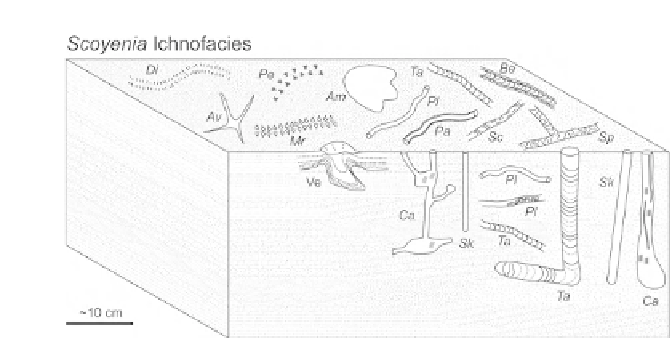Environmental Engineering Reference
In-Depth Information
FIGURE 4
Box diagram showing common ichnogenera of the
Scoyenia
Ichnofacies. The ichno-
facies can be informally grouped by similar morphologies, sizes, and orientations that show com-
mon associations between ichnotaxa (see
Table 2
). Bird footprints (Group 1):
Av
,
Avipeda
. Tetrapod
and bipedal dinosaur tracks (Group 2):
Am
,
Amblydactylus
. Arthropod trackways (Group 3):
Di
,
Diplichnites
;
Pe
,
Paleohelcura
;
Mr
,
Merostomichnites;
Ve, vertebrate tracks in cross section.
Horizontal, shallow-tier burrows (predesiccation suite; Group 4a):
Ta
,
Taenidium
;
Be
,
Beaconites
;
Pl
,
Planolites
;
Pa
,
Palaeophycus
. Horizontal, shallow-tier burrows (post-desiccation suite; Group
4b):
Sc
,
Scoyenia
;
Sp
,
Spongeliomorpha
. Vertical, deeper-tier burrows (Group 5):
Ta
,
Taenidium
;
Sk
,
Skolithos
. 3D branching burrow networks (Group 6):
Ca
,
Camborygma
.
dominated by horizontal backfilled burrows (
Hamer and Sheldon, 2010;
Hasiotis, 2007; Hasiotis and Mitchell, 1993
). The transition from proximal
littoral to terrestrial areas within the zone of lake-level rise and fall, with pro-
gressively deeper water tables and decreasing frequencies of flooding cycles
toward the basin margin, may have an important effect on the makeup of the
Scoyenia
Ichnofacies on the scale of suites or ichnocoenoses.
Likewise, vertebrate footprint assemblages, which are typically preserved in
low-energy lake margins, also show a characteristic zonation from the edge
of the water body to drier substrates, in terms of both their composition and
morphology or taphonomy (
Cohen et al., 1991, 1993; Hunt and Lucas, 2007;
Lockley, 1986; Lockley et al., 1994; Smith, 1993
). Five vertebrate ichnofacies
were proposed by
Hunt and Lucas (2007)
: (1)
Characichnos
, comprising ver-
tebrate swim traces within standing water bodies; (2)
Grallator
, comparable to
the shorebird ichnofacies of
Lockley et al. (1994)
, comprises high-density tri-
dactyl footprints of bipedal animals along shorelines; (3)
Brontopodichnus
and
(4)
Batrachichnus
, comprise impressions produced by quadrupedal herbivores
and carnivores in lake-margin areas; and (5)
Chelichnus
, being characterized by
trackways of amphibians and reptiles produced in eolian environments.
Although some workers consider vertebrate-footprint assemblages as separate
entities from invertebrate trace fossils present in the same deposits, this simply
derives from different research focuses (
Lockley, 2007
). The treatment of ver-
tebrate trace fossils together with invertebrate trace fossils allows for (1) the
refined interpretation of paleoenvironments and ichnological models in the






Search WWH ::

Custom Search